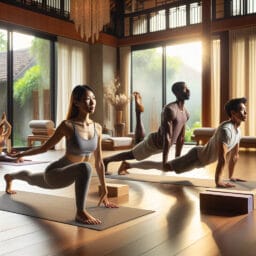
10 Wellness Tips to Improve Your Balance and Coordination
Table of Contents
- Introduction
- Understanding Balance and Coordination
- Tip 1: Practice Yoga Regularly
- Tip 2: Include Tai Chi in Your Routine
- Tip 3: Strengthen Your Core
- Tip 4: Focus on Posture
- Tip 5: Try Balance Training Exercises
- Tip 6: Engage in Aerobic Activities
- Tip 7: Perform Coordination Drills
- Tip 8: Play Sports or Dance
- Tip 9: Get Enough Sleep
- Tip 10: Stay Hydrated and Eat a Balanced Diet
- Conclusion
- Frequently Asked Questions
Introduction
Did you know that improving balance can actually increase your brain’s alertness? Balance exercises are like a fun workout for your brain, too! By practicing extending your leg and balancing on one foot, or walking backwards in a straight line, you’re not just building stability strength in those legs; you’re also giving your noggin a good ol’ stretch. And let’s talk about the Bosu ball – it’s like a half squishy ball that makes staying steady extra tricky but super good for keeping that core engaged and hips stable. If you keep at it, these nifty moves help prevent falls as we grow older. Because staying upright isn’t just about strong muscles; it’s about telling those anklebones and knees to work together to keep us tall and proud – coordination stands crucial! So hop on one foot, stand with arms folded, or try heel raises beside your favorite chair – each little step helps promote better balance and keeps life tumble-free!
Understanding Balance and Coordination
Did you know that every time you tie your shoes or hop out of bed, you’re using a secret superpower? Yep, balance and coordination are like the dynamic duo helping you move smoothly and avoid taking a tumble. These two heroes work together thanks to something called the vestibular system – it’s in your inner ear and acts like a level in a video game, keeping you nice and steady.
Here’s the scoop: When we weave coordination exercises into our fitness routine, we’re not just showing off at the gym—we’re making sure our motor skills stay sharp. Think about walking backwards or standing on one foot with your eyes closed—it might sound like playing, but these moves actually crank up your coordination and build stability strength.
Why does this matter? Well, as we skip through life, our stride shortens and steps slow down. That’s why practicing exercises to keep our lower body strong means we can strut confidently without worry. Plus, staying active helps bones stay dense which is super important for preventing falls that could lead to owies.
So next time you stand tall and stretch high or nail that heel raise beside your couch—think about this: You’re not just working out; you’re tuning up your body’s balance system so it can protect you better than any superhero cape! Now go ahead—place your nonsupporting foot directly beside the other one and let that anklebone touch as if it’s thanking its buddy for always being there. Enjoy becoming a balance boss!
Tip 1: Practice Yoga Regularly
Picture this: You’re a majestic tree, arms reaching for the sky, feet rooted deep into the ground. That’s the Tree Pose in yoga, and it’s not just about looking cool – it’s a fantastic way to improve your balance and stability! Yoga is a game-changer for those seeking ways to enhance balance. With poses like Warrior III where you’re poised on one leg, or Eagle Pose which has you twisting like a pretzel (but feeling oh-so-good!), every pose is an opportunity to build stability strength.
When you practice these poses, keep your core engaged and imagine stacking each part of your body in a straight line – head over heart, hips stable over ankles. These moves can dramatically increase flexibility while reinforcing bone density—a total win-win! Plus, as you focus on keeping that nonsupporting foot touching the standing leg (without the wobbles), you nudge your motor skills up a notch.
So whether you’re holding that knee-lifting Half Moon pose or tiptoeing into Dancer’s pose with eyes closed (for an extra challenge), remember: every time you wobble and don’t fall, repeat that stretch—you’re teaching your body to avoid dangerous falls. Yoga isn’t just about touching toes; it’s about grounding yourself so deeply that improving balance becomes as natural as breathing. Embrace being that tree—stand tall and let your limbs sway; they’ll always find their way back to center, leaving you stronger with each passing gust.
Tip 2: Include Tai Chi in Your Routine
Tai Chi might seem like a slow dance, but it’s actually a super stealthy way to boost your balance and get zen all at once. This ancient practice is like a secret spell for feeling more stable on your feet and in your mind. By shifting weight from one leg to the other through gentle, flowing movements, you’re teaching your muscles to whisper to each other – that’s right, better communication between those muscle buddies means less chance of wobbly legs and “oops” moments. Plus, Tai Chi is perfect for all ages; it’s a low-impact way to keep joints happy and maintain bone density without any herky-jerky moves.
Starting with basic Tai Chi steps, imagine yourself as smooth as silk – each motion glides into the next without hurry. With each position you hold (don’t worry if you can only do a few seconds before shaking – it gets easier!), you’re inviting calmness into your day while giving your lower body the thumbs-up to build stability strength. Lower body wobbles? Psh, not for long! As you sway softly like a tree in the breeze but stay rooted firmly, picture every cell in your body learning this crucial survival skill: staying upright without fuss.
Before you know it, those initially tricky foot stands become second nature, and walking backwards won’t feel so backward anymore. Even with eyes closed (make sure there’s nothing around to trip over first!), you’ll find that inner compass keeping you steady. So don’t just stand there—float into some Tai Chi and watch how gravity becomes just another friend helping you stick those landings!

Tip 3: Strengthen Your Core
Did you ever think of your core as your body’s command center? It’s true! For superheroes-in-training looking to enhance balance and prevent those sneaky falls, the mission begins right at the belly button. Core exercises aren’t just about having a six-pack; they are essential components for maintaining stability. Planking might not sound like an adventure, but it turns on your tummy’s tightrope walker mode. By keeping that belly button pulled toward the spine, we make sure our hips stay stable and don’t do that wiggly dance when we least expect it.
When you engage in activities like side planks or Pilates scissors, you’re giving orders to all those muscles around your middle – from front to back – telling them to wake up and hold you steady. This kind of training is key because a strong core means better balance, which in turn keeps us nimble on our feet. It’s said that as the body ages, reasons people lose their steadiness include weakening muscles and slowing steps. But by staying active and incorporating these core-strengthening heroes into our fitness routine, we can stand tall against time.
And here’s a fun fact: strengthening your core can even help with walking backwards without losing your footing – talk about coordination exercises with a twist! So next time you’re doing heel raises or aiming for that perfect foot stand starting position, tighten up that tummy as if preparing for liftoff—it’s one small squeeze for man, one giant leap for staying upright!
Tip 4: Focus on Posture
Did you know that standing tall isn’t just for soldiers on parade? Good posture is the secret sauce to keeping your balance and coordination skills in tip-top shape! When we slouch, our bodies are like a tower of blocks ready to topple over. But stand up straight, and voila! You become as stable as a lighthouse against crashing waves. Keeping a good posture throughout the day means your spine’s happy, which makes balancing a breeze.
So here’s the trick: pretend there’s an invisible string pulling you up from the top of your head—this helps keep your neck long and shoulders back without being stiff. While working at your desk or stirring up magic in the kitchen, take mini posture checks. Place that foot directly under you and align those hips with shoulders like they’re best buds having a polite handshake. Even when sitting, imagine those anklebones touching lightly beneath your chair; this simple act keeps everything lined up nicely. It’s these everyday moments that can turn into essential components for improving stability strength—just by standing tall and proud like a superhero ready for action!
Tip 5: Try Balance Training Exercises
Ever wonder how tightrope walkers stay so nimble up in the air? It’s all about mastering balance training, and guess what – you can do it too, right on solid ground! Balance training isn’t just for circus acts; it’s a secret weapon for everyone to keep muscles chatty and joints like butter. Dabble in some balance exercises using cool gear like the bosu ball—imagine it as your own wobbly platform to conquer! This half-dome can transform plain old squats into a thrilling challenge that keeps your core engaged and builds stability strength faster than a cat’s reflexes.
And there’s more to this balancing act. You know those movie scenes where heroes dodge laser beams? Picture yourself doing that but with cone taps or side lunges – no lasers needed, though! Each sidestep or tap is an essential component of your fitness routine, helping your lower body chat with the upper half to avoid dangerous falls. As you stride through these motions, remember each foot stand plants seeds for a sturdier you. Lose balance overtime? Not on watch! These coordination exercises are like secret missions prepping you for life’s unexpected twists and turns, ensuring that even if steps slow down or stride shortens, you’ll still be standing tall – ready for whatever comes next.
Tip 6: Engage in Aerobic Activities
Did you know that getting your heart rate up with aerobic exercises does more than just boost stamina? It’s also a fantastic strategy to enhance coordination and overall fitness! When we engage in activities like jumping jacks, dancing, or even brisk walking, we’re not only burning calories but also fine-tuning our motor skills. These energetic movements require our brain to coordinate with limbs in a rhythm, making sure every arm swing and leg hop lands just right. Regular aerobic exercise keeps the whole body in sync—like a well-oiled machine—reducing the time it takes for messages to travel from our brain to our muscles.
Consistency is key: as you keep active with these heart-pumping workouts, you promote balance and help prevent falls by strengthening the very muscles that keep us upright. Plus, pushing past those huff-and-puff moments can increase flexibility and bone density, ensuring both young sprouts and wise owls can stand tall without faltering. Whether you’re boogieing down on the dance floor or power-walking through the park, every step is an essential component of maintaining balance—the secret ingredient for a life full of steady adventures!
Tip 7: Perform Coordination Drills
When we think of superheroes, their amazing balance often comes to mind! Just like them, our bodies have this incredible network called the nervous system that acts as our own superpower, quietly working in the background. Engaging in simple coordination drills daily sharpens this system and improves our motor skills. These fun activities—like standing on a cushion while brushing teeth or playing catch with soft balls—teach our body to react quicker and with more precision. Improving stability isn’t just about preventing falls; it’s also about boosting how efficiently our nervous system communicates with muscles during all everyday activities!
For instance, whenever you switch from walking to suddenly stopping at a street corner, your brain sends super-fast messages so you don’t trip over your own feet. Exercises where hips stay lower than shoulders or where nonsupporting foot barely touches the ground are not just games; they’re key exercises in making sure every nerve and muscle is ready for action. This way, even if stride shortens or steps slow down as years go by, these essential components of fitness keep us active and spry – well into our caped crusader years! So next time you do those heel raises or aim for that perfect foot stand starting position, picture each move charging up your inner superhero, ready to save the day with smooth moves and steady grace.
Tip 8: Play Sports or Dance
Did you know that some sports are practically a secret training ground for turning you into a balance and coordination ninja? Take skateboarding or surfing, for example—these rad activities require you to constantly adjust your body to stay on board, which is epic for building stability strength. Each ollie or wave ride teaches your muscles to chat in real time, making sure you don’t wipe out.
Now let’s shimmy over to dancing—it’s like a party for your motor skills! Grooving to the rhythm isn’t just about having fun (though it totally is); it’s also an amazing way to enhance balance and bone density. Whether it’s hip-hop, ballet, or salsa, every spin and step increases flexibility while keeping those hips stable. Plus, as the music takes over and you find yourself lost in the flow, your brain is actually getting a solid workout as well—not only improving your moves but also boosting that crucial survival skill of staying upright when life throws offbeat rhythms your way.
So next time you lace up those sneakers or hit the dance floor, embrace the challenge. You’re not just playing sports or busting moves; you’re crafting a fitter, more balanced version of yourself—one that stands tall and confident no matter what comes twirling by!

Tip 9: Get Enough Sleep
Ever imagined your nightly snooze as a secret weapon for ace balance and coordination? It’s true! Getting zzz’s is like hitting the refresh button on our bodies, making sure we wake up ready to stand steady. A good night’s sleep sets us up for success; without it, our muscles might get grumpy, and our motor skills could go on a mini-vacation. To ensure you’re giving your balance the best boost, stick to a sleep schedule that has you counting sheep at the same time each night. Keep your room dark and cool—think of it as your cozy cave for dreamy adventures. And avoid those sneaky screens before bedtime; their glow can trick brains into thinking it’s party time when it’s really slumber o’clock! With these sleep-smart moves, you’ll be building stability strength even while snuggled under the covers—resting up to promote balance and prevent falls during your wide-awake heroics!
Tip 10: Stay Hydrated and Eat a Balanced Diet
Did you know that munching on the right snacks can be just as important as those neat balance exercises? Yup, nutrition and hydration play a superhero role in keeping us steady on our feet. Imagine your body as a high-tech machine; to keep all parts working smoothly – especially for maintaining balance – it needs top-notch fuel. Crunch on almonds or walnuts to give your muscles the energy they need for stability strength. Sip water like it’s a magic potion because staying hydrated means better concentration and coordination. And don’t forget those leafy greens! They’re packed with calcium which is key for bone density and preventing falls. So, grab a banana or gulp down some water before practicing extending that leg – every bite and every sip are essential components in your quest to enhance balance and become a coordination ninja!
| Nutrient/Item | Benefits | Examples |
|---|---|---|
| Healthy Fats | Provide energy for muscle stability and strength | Almonds, Walnuts |
| Hydration | Improves concentration and coordination | Water |
| Calcium | Key for bone density and preventing falls | Leafy Greens |
| Potassium | Helps with muscle function and nerve signals | Bananas |
Conclusion
Ready to become a stability superstar? Stepping up your balance game is easier than you think with some everyday magic. While you’ve learned a heap about heel raises and nonsupporting foot wiggles, there’s another hero in the mix—your breath! Like an invisible coach, breathing deeply centers your gravity and calms those jittery nerves, helping you stand tall and confident. Imagine filling up like a balloon before each balance exercise; it’s not just hot air—it’s fuel for focus. It’s crucial to weave this simple yet powerful step into your fitness routine, transforming even grocery standing lines into chances to promote balance and sharpen those motor skills. So next time life feels like a tightrope walk, take a deep breath and know you’re prepped to strut across with grace!



